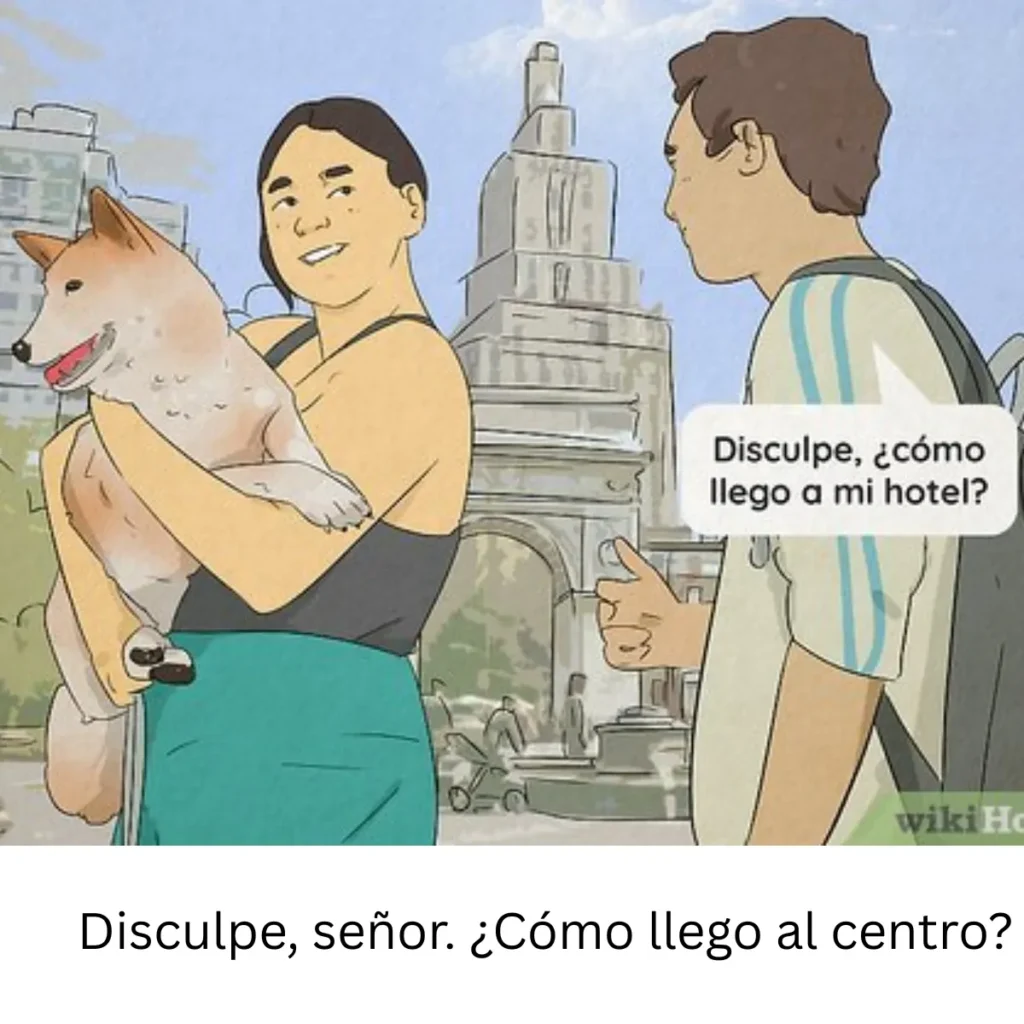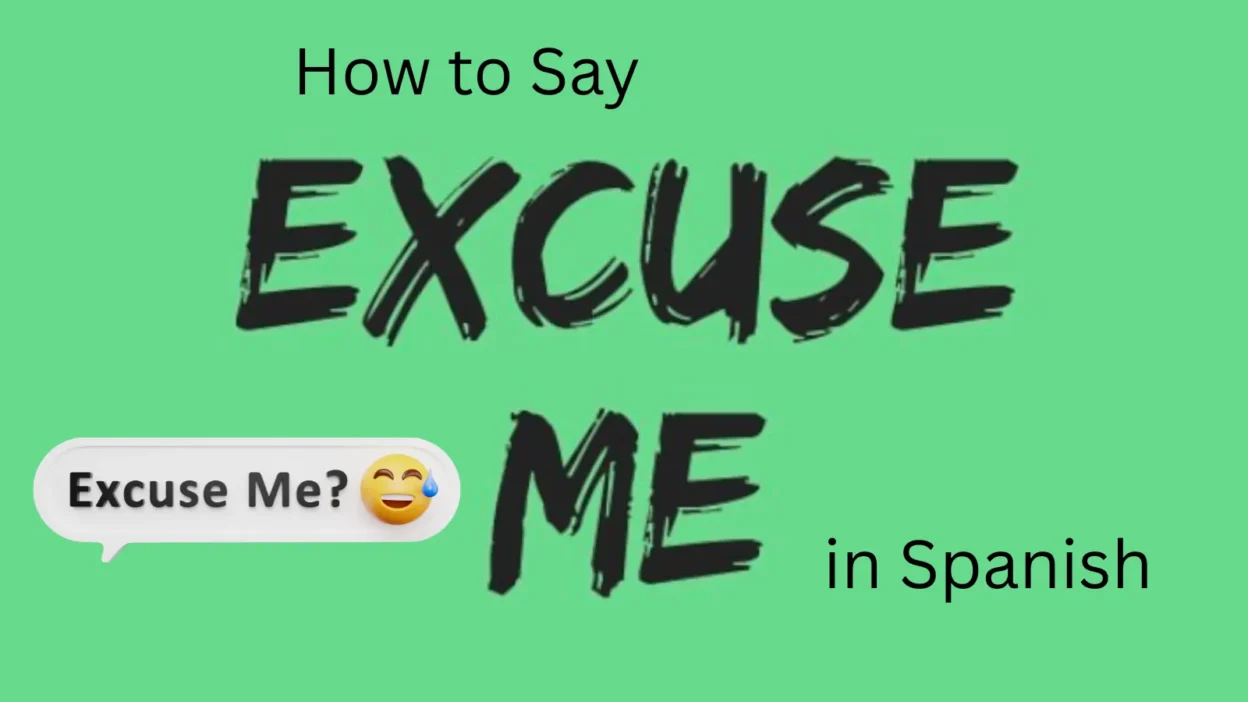Learning how to say excuse me in Spanish is essential for polite and respectful communication. Whether you’re navigating through a crowded street, getting someone’s attention, or apologizing for a small mistake, using the right phrase can make a big difference.
Spanish offers several expressions for excuse me, each suited to different situations and levels of formality, so knowing when and how to use them will help you sound more natural and courteous. Plus, it shows cultural awareness and respect, which locals always appreciate. Mastering these phrases will make your interactions smoother and more friendly..
Say Excuse me in Spanish
Here are 15 different ways to say excuse me in Spanish, complete with realistic dialogues and origins or usage tips so you can speak with cultural accuracy and ease.
Excuse Me in Spanish – 15 Phrases with Pronunciation, Meaning, and Context
| Spanish Phrase | Pronunciation | Meaning | Context | Level |
|---|---|---|---|---|
| Perdón | pehr-DOHN | Sorry / Excuse me | General apology or minor mistake | 🟡 Neutral |
| Disculpe | dees-KOOL-peh | Excuse me | Formal situations, addressing strangers | 🔵 Formal |
| Disculpa | dees-KOOL-pah | Excuse me | Informal situations with friends/family | 🟢 Informal |
| Perdóname | pehr-DOH-nah-meh | Forgive me / Excuse me | Asking forgiveness personally | 🟢 Informal |
| Con permiso | kohn pehr-MEE-soh | With permission / Excuse me | When passing by someone | 🔵 Formal |
| Lo siento | loh SYEN-toh | I’m sorry | Expressing regret or sympathy | 🟡 Neutral |
| Un momento, por favor | oon moh-MEN-toh por fah-VOR | One moment, please | Politely asking for time or attention | 🔵 Formal |
| Perdona la molestia | pehr-DOH-nah lah moh-LES-tyah | Sorry for the inconvenience | Apologizing for interrupting or bothering | 🔵 Formal |
| Perdone usted | pehr-DOH-neh oos-TEHD | Excuse me (very polite) | Formal apology to strangers/elders | 🔵 Formal |
| Disculpen | dees-KOOL-pehn | Excuse me (plural) | Addressing a group | 🔵 Formal |
| ¿Me permite? | meh pehr-MEE-teh | May I? / Excuse me | Asking permission politely | 🔵 Formal |
| ¿Podría pasar? | poh-DREE-ah pah-SAR | Could I pass? | When trying to move past someone | 🔵 Formal |
| ¿Me disculpa? | meh dees-KOOL-pah | Will you excuse me? | Asking for pardon politely | 🔵 Formal |
| Perdona | pehr-DOH-nah | Sorry (casual) | Informal quick apology | 🟢 Informal |
| Mil disculpas | meel dees-KOOL-pahs | A thousand apologies | Strong apology or regret | 🟡 Neutral |
Legend:
🔵 Formal | 🟢 Informal | 🟡 Neutral (works in both)
1. Perdón – Sorry / Excuse me
Origin:
From the verb perdonar (to forgive), perdón is used for light apologies or getting someone’s attention.
Example:
👤 Usuario A: Perdón, ¿esta silla está ocupada?
👤 Usuario B: No, adelante.
Use: Common across all Spanish-speaking countries; polite and neutral.
2. Disculpe – Excuse me (formal)

Origin:
From disculpar (to excuse), used in more formal contexts—like speaking to strangers, elders, or in professional settings.
Example:
👤 Usuario A: Disculpe, señor. ¿Cómo llego al centro?
👤 Usuario B: Tome la calle principal, y ahí está.
Use: Very polite and formal.
3. Disculpa – Excuse me (informal)
Origin:
Same root as disculpe, but used with friends, peers, or people your own age.
Example:
👤 Usuario A: Disculpa, ¿me prestas tu lápiz?
👤 Usuario B: Claro, aquí tienes.
Use: Informal; used when addressing someone casually.
4. Con permiso – Excuse me (when passing by)
Origin:
Literally means “with permission.” Used when moving through a crowd or needing space.
Example:
👤 Usuario A: Con permiso.
👤 Usuario B: Adelante.
Use: Widely used in Latin America; polite and practical.
5. Lo siento – I’m sorry

Origin:
Literally means “I feel it.” A deeper apology than perdón, used when you’ve done something wrong.
Example:
👤 Usuario A: Lo siento por llegar tarde.
👤 Usuario B: No te preocupes.
Use: Formal or emotional apologies.
6. Ay, perdón – Oh, excuse me!
Origin:
An exclamatory version of perdón, often said reflexively after bumping into someone or making a small mistake.
Example:
👤 Usuario A: ¡Ay, perdón! No te vi.
👤 Usuario B: Está bien, no hay problema.
Use: Casual and immediate.
7. Perdóneme – Forgive me (very formal or religious)

Origin:
More intense form of perdón, often used for formal apologies or confessions.
Example:
👤 Usuario A: Perdóneme, padre, porque he pecado.
👤 Usuario B: Te escucho, hijo.
Use: Religious or solemn tone.
8. Perdone – Excuse me (usted form)
Origin:
The usted (formal) conjugation of perdonar. Used in Spain and Latin America with elders or in business.
Example:
👤 Usuario A: Perdone, ¿podría repetir eso?
👤 Usuario B: Claro, no hay problema.
Use: Formal.
9. Disculpad – Excuse me (vosotros form)
Origin:
Used in Spain when addressing a group informally.
Example:
👤 Usuario A: Disculpad, ¿sabéis dónde está el museo?
👤 Usuario B: Sí, está a dos calles de aquí.
Use: Regional to Spain; informal group address.
10. Disculpen – Excuse me (to a group)
Origin:
Plural form of disculpe, used when speaking to more than one person respectfully.
Example:
👤 Usuario A: Disculpen, ¿puedo hacer una pregunta?
👤 Usuario B: Por supuesto.
Use: Formal and plural.
11. Permiso – Permission / Excuse me
Origin:
Shortened slang form of con permiso, used especially in urban Latin America.
Example:
👤 Usuario A: Permiso, necesito pasar.
👤 Usuario B: Pasa, pasa.
Use: Informal and quick.
12. Una disculpa – An apology
Origin:
Common in Mexico; used when acknowledging a mistake with politeness.
Example:
👤 Usuario A: Una disculpa, no fue mi intención.
👤 Usuario B: Todo bien.
Use: Courteous and often used in customer service.
13. Mis disculpas – My apologies
Origin:
A slightly more formal phrase, often used in writing or professional contexts.
Example:
👤 Usuario A: Mis disculpas por el error en el documento.
👤 Usuario B: Gracias por corregirlo.
Use: Formal and respectful.
14. Perdón por… – Excuse me for…
Origin:
A fuller sentence structure to specify the reason for the apology.
Example:
👤 Usuario A: Perdón por interrumpir, pero ¿puedo hablar contigo?
👤 Usuario B: Claro, dime.
Use: Polite and situational.
15. ¡Disculpa la molestia! – Sorry for the bother!
Origin:
Used when requesting help or when you feel you’re inconveniencing someone.
Example:
👤 Usuario A: Disculpa la molestia, ¿tienes cambio para un billete?
👤 Usuario B: Sí, aquí tienes.
Use: Common in street interactions, especially in Latin America.
Conclusion:
Learning how to say excuse me in Spanish is more than just memorizing words—it’s about showing politeness, respect, and cultural understanding. Whether you’re in a formal setting, asking for directions, or simply passing through a crowd, the right phrase can leave a positive impression.With practice, these expressions will become second nature, helping you communicate more effectively and confidently in any Spanish-speaking environment.



